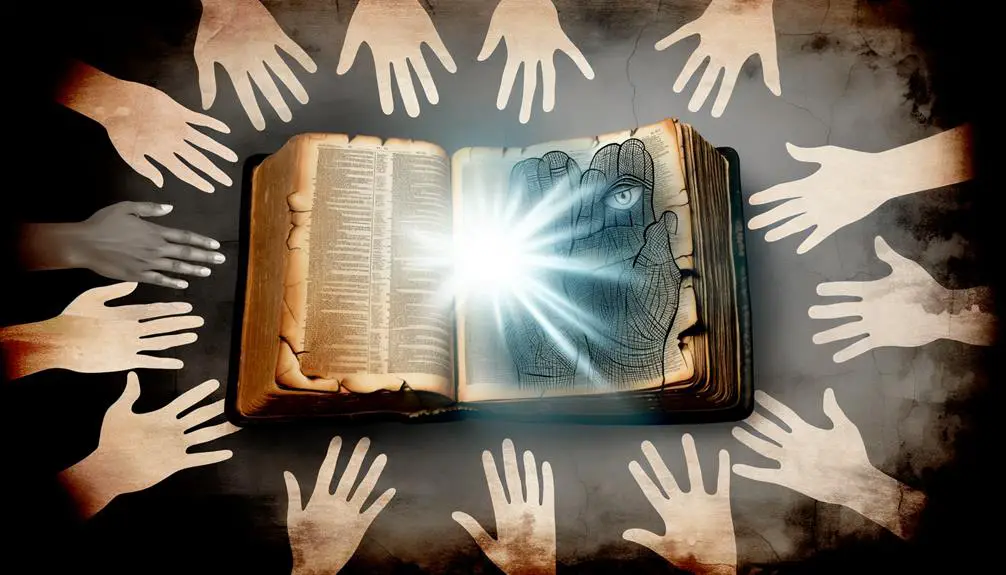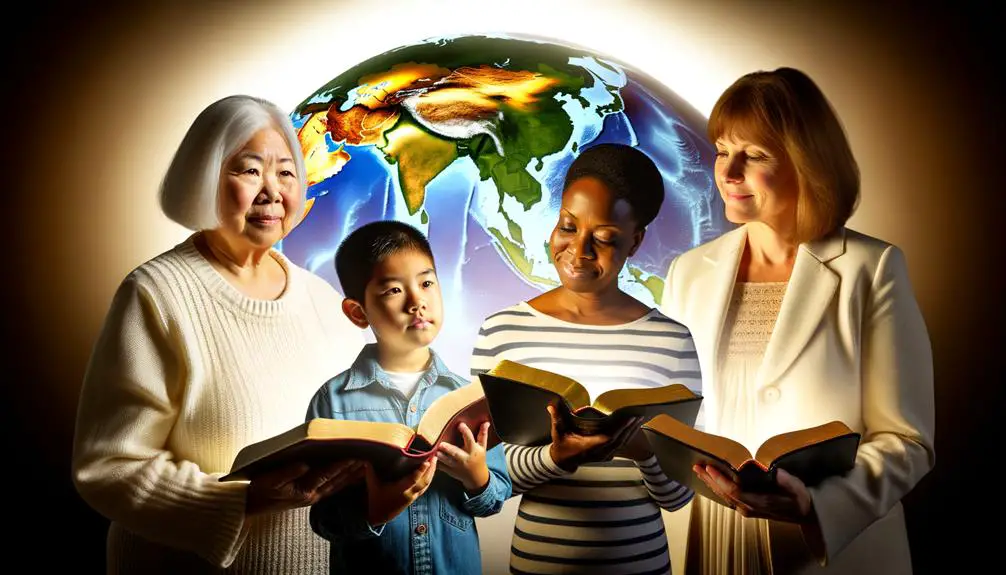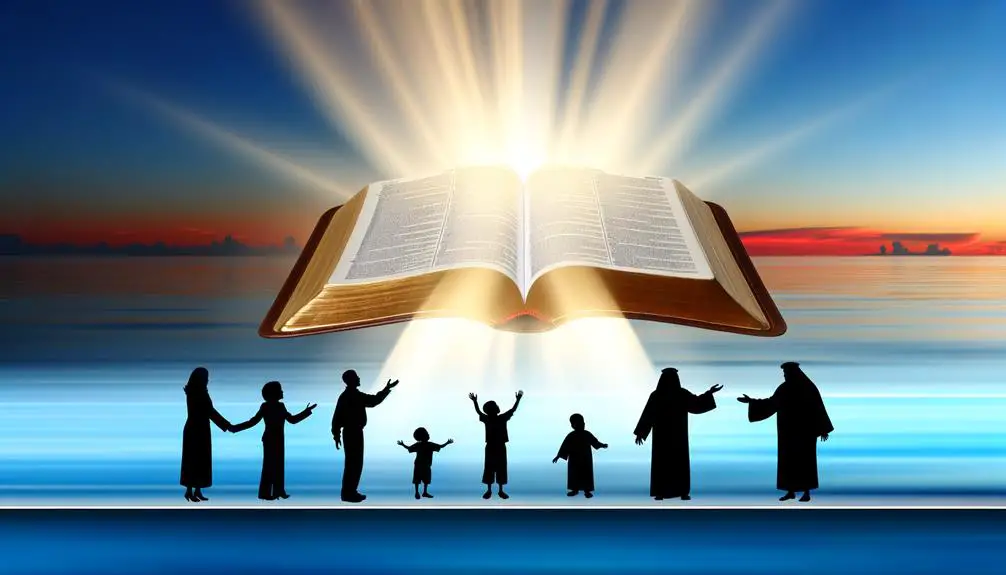See why John 3:16's profound message has made it the Bible's most quoted verse, revealing its deep impact on culture and theology.

Most Quoted Verse in the Bible
Have you ever wondered if there's truth to the claim that John 3:16 is the most quoted verse in the Bible? It's a question that not only touches on biblical literacy but also delves into the cultural and theological significance of scripture.
As we explore the historical footprint of this verse, its profound impact on theology, and its ubiquitous presence in modern culture, you'll find that the story behind its prominence is as captivating as the verse itself.
This journey through scripture, history, and personal narratives promises to shed light on why this verse resonates so deeply across different spectrums.
Key Takeaways
- John 3:16 is central to Christian theology, deeply influencing societal and legislative norms.
- Its translation and interpretation have evolved, reflecting shifts in cultural and societal values.
- The verse's themes have permeated literature, art, and media, showcasing its broad cultural impact.
- John 3:16 has played a significant role in shaping both religious doctrine and public policy debates.
The Verse Revealed

The most frequently cited verse in the Bible is John 3:16, encompassing a profound message of faith and redemption. You're embarking on an exploration of its origin and the accuracy of its translations, elements that are critical to understanding its widespread impact and reverence.
John 3:16 originates from the Christian New Testament, specifically within the Gospel according to John. It's part of a conversation between Jesus and Nicodemus, a Pharisee, highlighting the concept of salvation through faith in Jesus Christ. The verse's origin within a direct discourse between two significant biblical figures adds layers of theological and historical complexity, making its accurate translation and interpretation paramount for scholars and believers alike.
Translation accuracy is a pivotal aspect of preserving the verse's intended message. The original texts of the New Testament were written in Koine Greek, a dialect that requires careful linguistic and cultural consideration to translate accurately into contemporary languages. Over centuries, translators have grappled with conveying not just the literal meaning of the words but the theological nuances they carry. Variations in translation can lead to differing interpretations, affecting theological beliefs and practices.
Scholarly analysis of John 3:16 emphasizes the importance of a meticulous approach to its translation, ensuring that the profound message of faith and redemption it conveys is accessible and faithful to its original intent. As you delve deeper into the verse's significance, understanding its origin and the challenges surrounding its translation accuracy provides a foundational context that enriches your appreciation of its enduring impact.
Historical Significance

You'll find that the historical significance of the most quoted verse in the Bible encompasses a broad spectrum, from its cultural impact assessment to its interpretation through ages, and its influence on legislation.
This verse hasn't only shaped theological discourse but has also left its mark on societal norms and legal frameworks across various civilizations.
Analyzing these facets provides insight into the verse's enduring relevance and its role in molding human thought and governance over centuries.
Cultural Impact Assessment
Assessing the cultural impact of the most quoted verse in the Bible reveals its profound influence on literature, art, and societal values over centuries. This verse's global perceptions shape not only religious thought but also secular interpretations, highlighting its universal appeal and adaptability.
Literary comparisons further underscore its significance, as writers across ages and cultures have drawn inspiration or sought contrast with its themes. Such engagements demonstrate the verse's ability to transcend its original religious context, influencing a broad spectrum of cultural expressions.
Its enduring relevance is a testament to the complex interplay between sacred texts and human creativity, reflecting an ongoing dialogue between ancient wisdom and contemporary challenges. This analysis showcases the verse's pivotal role in molding collective consciousness and cultural landscapes worldwide.
Interpretation Through Ages
Exploring the historical significance of the most quoted verse in the Bible, we uncover how its interpretations have evolved over centuries, reflecting shifts in societal norms and philosophical inquiries.
Translation challenges have been significant, as scholars grapple with conveying the original meanings across diverse languages and cultures. These challenges aren't merely linguistic but also cultural, requiring a deep understanding of ancient contexts to ensure accurate modern interpretations.
Furthermore, the verse's influence on artistic expressions is profound. Artists across generations have drawn inspiration from its words, embedding its themes into various mediums—painting, literature, music, and more. Through these artistic expressions, the verse's interpretations have been visually and emotionally communicated, extending its impact beyond the written word and into the collective human experience.
Influence on Legislation
The most quoted verse in the Bible has significantly shaped legislative frameworks throughout history, reflecting its deep-rooted influence on societal laws and moral codes. This influence is evident in various ways:
- Foundation of Laws: Many legal systems have origins in biblical principles, guiding the creation of laws that emphasize justice, equity, and compassion.
- Legal Controversies: In debates over contentious issues, sides often cite this verse to support their arguments, showcasing its role in shaping public policy and legal standards.
- Policy Debates: The verse's moral teachings have infiltrated policy debates, influencing legislation on social welfare, criminal justice, and human rights.
Analyzing its impact, it's clear that the verse's ethical directives have profoundly contributed to the development and evolution of legal and societal norms.
Theological Implications

You'll find the theological implications of the most quoted verse in the Bible are profound and multifaceted.
Interpretive variations across denominations shed light on the rich tapestry of Christian belief, emphasizing the diversity within unity.
Ethical lessons and insights, alongside the impact on Christian doctrine, underscore the verse's foundational role in shaping moral and doctrinal perspectives.
Interpretive Variations Across Denominations
While interpretations of the most quoted verse in the Bible vary widely across denominations, these differences underscore significant theological implications. These variations not only reflect diverse doctrinal stances but also influence the nature of ecumenical dialogues. Understanding these interpretive differences requires a consideration of:
- Translation nuances: Different translations of the Bible can lead to varied understandings of the same verse, affecting theological interpretations.
- Historical context: Each denomination's historical development informs its interpretive lens, shaping how scripture is understood and applied.
- Theological emphasis: Denominations prioritize different aspects of theology, which can lead to distinct readings of the same text.
Engaging with these factors deepens one's appreciation for the complexity of biblical interpretation and the necessity of ongoing dialogue across Christian traditions.
Ethical Lessons and Insights
Delving into the most quoted verse in the Bible reveals a rich tapestry of ethical lessons and insights with profound theological implications. This exploration illuminates the nuanced terrain of moral ambiguity, challenging you to confront and navigate the complexities inherent in ethical decision-making.
Through this lens, the verse acts as a mirror, reflecting societal values and dilemmas, urging a deeper contemplation of one's actions and their ripple effects across communities. These reflections underscore the interconnectedness of individual morality and societal well-being, highlighting the pivotal role of scriptural interpretations in shaping ethical norms.
Thus, engaging with this verse not only fosters personal moral growth but also offers a framework for evaluating and responding to the ethical challenges embedded within societal reflections.
Impact on Christian Doctrine
How does the most quoted verse in the Bible influence Christian doctrine and its theological underpinnings? Its prevalence and emphasis shape doctrine formation and belief evolution in significant ways:
- Foundation for Core Beliefs: It provides a foundational scripture that underpins central Christian beliefs, guiding doctrinal development.
- Belief Evolution: Over time, the interpretation of this verse has evolved, reflecting changes in societal values and theological understanding, thereby influencing the evolution of Christian doctrine.
- Interdenominational Unity and Divergence: The verse acts as a common ground for many denominations, yet its varied interpretations foster theological diversity, impacting how different Christian communities understand and practice their faith.
Through these mechanisms, the most quoted verse plays a pivotal role in shaping the theological landscape of Christianity.
Cultural Impact

The cultural impact of the most quoted verse in the Bible extends beyond religious contexts, influencing various aspects of art, literature, and public discourse. This significant influence is evident in the diverse artistic representations and social debates it has sparked over the years.
Artistic representations of this verse have permeated various forms of media, from classical paintings to modern digital art, each interpreting its message through the lens of the artist's cultural and historical context. These artworks not only serve as a testament to the verse's enduring relevance but also offer insights into the evolving perceptions of spirituality and morality within society. Through visual art, the verse becomes a multi-faceted symbol, evoking a spectrum of emotions and reflections on human existence, divine grace, and the quest for meaning.
Furthermore, the verse's ubiquity has made it a focal point in social debates, where it's often cited to advocate for compassion, equality, and justice. Its powerful message has been mobilized in movements addressing social injustices, human rights, and ethical governance, showcasing its ability to resonate across different ideologies and inspire collective action. In these discussions, the verse acts as a moral compass, challenging individuals and communities to reflect on their values and the kind of society they aspire to create.
Personal Stories of Influence

Beyond its broad cultural resonance, individual narratives reveal the profound personal impact of the most quoted verse in the Bible, shaping lives and inspiring transformative journeys. These stories, often shared in heartfelt testimonies, underscore the capacity of this verse to catalyze significant life changes and foster emotional healing.
To elucidate, consider the following:
- Life Changes: Many recount how encountering this verse at a pivotal moment led to a dramatic reevaluation of their life's direction. Whether it was a decision to change careers, mend relationships, or embark on a path of self-improvement, the verse served as a catalyst for profound personal transformation.
- Emotional Healing: Individuals often share stories of how this verse provided comfort and strength during times of deep emotional distress. Whether grappling with loss, battling addiction, or overcoming feelings of worthlessness, the words of the verse offered a source of solace and a reminder of their intrinsic value and potential for redemption.
- Community and Belonging: Beyond personal transformation, this verse frequently plays a role in fostering a sense of community and belonging. For many, its message has opened doors to new friendships and support networks, offering a sense of unity and shared purpose.
These personal narratives highlight the verse's role not just as a theological cornerstone, but as a living, breathing source of inspiration and change. Through its ability to resonate on such a deeply personal level, it continues to inspire, heal, and transform lives across the globe.
Quotations in Modern Media

In modern media, the most quoted verse in the Bible permeates various platforms, illustrating its enduring influence on contemporary culture and communication. You'll find its presence not just in religious contexts but significantly in media adaptations and cinematic references, demonstrating the verse's universal appeal and versatility. This phenomenon underscores the Bible's role as a foundational text, influencing narratives, themes, and dialogues across a spectrum of media.
The table below showcases examples of how this verse integrates into modern media, emphasizing its widespread application:
Media Type |
Title |
Context |
|---|---|---|
Movie |
*Pulp Fiction* |
Used as a recurring motif, illustrating redemption |
TV Show |
*The Simpsons* |
Parodied in various episodes, highlighting its cultural saturation |
Music |
*Losing My Religion* by R.E.M. |
References biblical themes, underscoring existential questions |
Book |
*The Road* by Cormac McCarthy |
Echoes themes of faith and survival, drawing from biblical imagery |
Video Game |
*Assassin's Creed* series |
Incorporates biblical references to enrich storytelling and character development |
Analyzing these examples, you can appreciate the depth of the Bible's influence on media. Its quotations serve not merely as decorative elements but as integral components that enhance narrative depth, character complexity, and thematic richness. Cinematic references, in particular, exploit this verse's potent symbolism and emotional resonance, embedding it in the collective consciousness of audiences worldwide.
Through media adaptations, the most quoted verse in the Bible transcends its original religious context, becoming a versatile tool for storytelling. Its presence across diverse media platforms confirms the Bible's enduring relevance and its profound impact on shaping and reflecting societal values and human experiences.
Future Resonance

Considering the Bible's pervasive influence across historical and contemporary media landscapes, it's compelling to speculate on how its most quoted verse will continue to resonate in future narratives and digital platforms. The integration of biblical texts, especially the most quoted verses, into future content is likely to undergo significant transformations, influenced by science integration and technological reflections. Here's how:
- Science Integration: As the boundaries between science and spirituality continue to blur, you'll find the most quoted verse weaving its way into discussions and debates around scientific discoveries and ethical dilemmas. This intersection won't only enrich dialogues but also challenge and expand the interpretative frameworks through which the Bible is understood.
- Technological Reflections: With the advent of augmented and virtual reality, the most quoted verse is likely to find new life within immersive experiences. These platforms can offer deeper, more nuanced explorations of biblical themes, allowing you to experience these ancient texts in ways previously unimaginable. The potential for personal reflection and communal discourse within these spaces is vast.
- Social Media Evolution: The role of social media in disseminating biblical verses can't be overstated. As platforms evolve, so too will the methods of sharing and reflecting on the most quoted verse. Expect to see innovative uses of AI to personalize scripture engagement, making the Bible's teachings more accessible and relevant to a global audience.
The future resonance of the Bible's most quoted verse will undoubtedly be shaped by these factors, among others. The ongoing dialogue between ancient texts and modern contexts promises to enrich both the personal and collective understanding of these enduring words.
Frequently Asked Questions
How Do Different Translations of the Bible Affect the Interpretation and Popularity of the Most Quoted Verse?
Different translations of the Bible, shaped by varying translation methodologies and linguistic diversity, significantly influence how you understand and appreciate its most quoted verse. The choice of words, the translators' cultural and theological biases, and the target audience's language all affect its interpretation and popularity.
You'll find that some translations might resonate more due to clearer language or cultural relevance, thereby impacting how often it's quoted and its overall influence.
Are There Any Notable Controversies or Debates Surrounding the Interpretation of the Most Quoted Verse in Academic or Religious Communities?
Diving into the heart of scholarly debate, you'll find that controversies around historical accuracy and interpretive methodologies have indeed stirred the academic and religious realms. These discussions aren't just intellectual sparring matches; they're quests to unearth the truth behind revered texts.
Through examining these divergences, scholars seek to bridge gaps between varying interpretations, ensuring that the essence of these debates enriches, rather than divides, the communities involved.
How Has the Frequency of Quoting This Verse Changed Over Time, and What Factors Have Influenced Its Fluctuation in Popularity?
You've noticed that the frequency of quoting this verse has changed over time, influenced by cultural shifts and historical events.
For instance, during periods of social upheaval or significant global incidents, its popularity might spike as people seek comfort or guidance.
Conversely, during more stable times, its usage could dwindle.
Analyzing these trends provides insight into how societal values and challenges shape the relevance and interpretation of religious texts over time.
Can the Most Quoted Verse in the Bible Be Linked to Specific Trends in Art, Literature, or Music Outside of Direct Religious Contexts?
You're diving into how certain phrases echo through time, touching everything from modern advertising to political speeches.
It's intriguing to analyze how these words, stripped from their original religious context, weave into the fabric of culture, influencing art, literature, and music.
What Psychological or Sociological Explanations Have Researchers Proposed for Why This Particular Verse Resonates so Strongly With People Across Different Cultures and Eras?
Researchers suggest this verse's strong resonance is due to its cultural universality and emotional appeal. You'll find it speaks to fundamental human experiences and emotions, transcending cultural and temporal boundaries.
Its themes of hope, redemption, or love, for instance, tap into universal human desires and fears. This broad relatability encourages reflection and connection across diverse communities, explaining its lasting impact across different cultures and eras.
Conclusion
In conclusion, the pervasive presence of this verse through various venues vividly validates its vast value. Historically hallowed, theologically thoughtful, and culturally consequential, its sentences have shaped societies and soothed souls.
Your engagement with its eloquence in everyday expressions and extensive expositions exemplifies its eternal echo. As it continues to connect communities and catalyze conversations, its spiritual significance and societal sway shall surely sustain.
Analyzing its ascent affirms the awe-inspiring ability of ancient aphorisms to adapt and anchor across ages.



Sign up